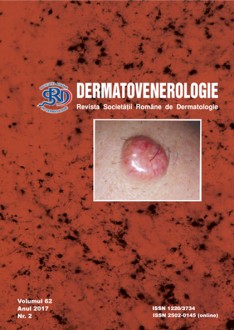Introduction. Darier’s disease, also known as Keratosis follicularis, Diskeratosis follicularis or White- Darier disease, is a dominant autosomal genodermatosis, with a variable penetrance. The worldwide prevalence of the disease is 1-4 cases/100.000 people. In the classical form of the disease, the lesions are frequently observed on the seborrheic regions (trunk, neck, ears, forehead, scalp and inguinal area), but they can also affect other areas. The lesions have a particular smell because of the bacterias present at their surface. The disease can affect the nails and mucosae and it can also be associated with epilepsy and schizophrenia. We are going to present 2 patients with Darier disease our goal being to highlight the clinicoevolutive, histopathological and therapeutical aspects of the disease.
Patients and method. We present two cases of Darier disease, clinically and histopathologically diagnosed. The particularities of this cases are represented by the on set age and the disposition of the lesions. The first patient received Medrol 32 mg (1 cp/day), Ranitidine 150 mg (2cp/day), Levocetirizine 5 mg (1 tb every 12 h), Amoxicilline/Clavulanic Acid 875/125 mg (1 cps/day), and the local treatment implied Fluticazone propionat. The second patient received Desloratadine 5 mg (1 cp/day), Ciprofloxacine 500 mg (1cp every 12 h) and the local treatment implied Fluticazone propionat. Both patients were discharged and received treatment with Acitretin 20 mg/day, antihistatimics, hepatic protectors and 3rd class dermatocorticoids.
Results. The histopathological exam confirmed the Darier disease diagnosis. Clinically, both patiens presented with nail disorders (longitudinal striae and onicolisis affectind the fingernails). The second patient also presented palmo-plantar hiperkeratosis and hiperkeratotic verrucous papules on the back of the hands. The DLQI score revealed an important alteration of the life quality of these patients (in the first case, DLQI score was 16 and in the second case, the score was 13). After one month of treatment, the evolution was slightly improved.
Conclusions. Darier’s disease is a chronic disease, with ondulant evolution, with temporary exacerbations and remissions, but with no complete and definite resolution. The psycho-social consequences appear due to the aspect of the eruption and the unpleasant smell of the lesions. The disease has an important impact over the quality of the patient’s life, this being the reason why we absolutely need to calculate the DLQI score.
Clinical cases
DARIER DISEASE – TWO CLINICAL CASES


